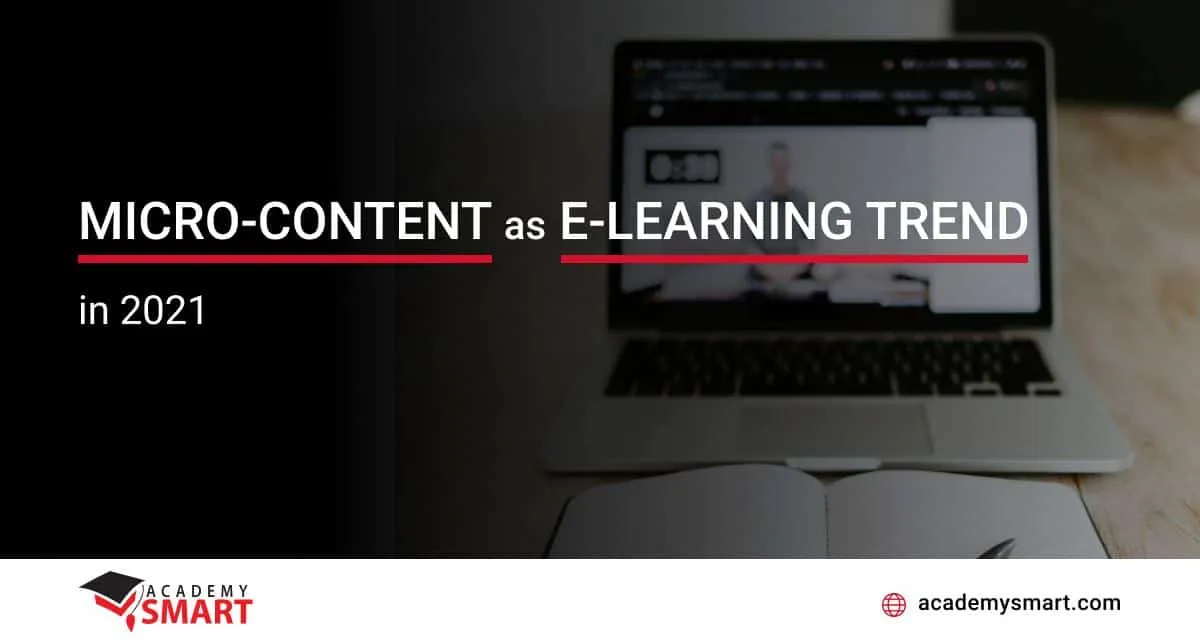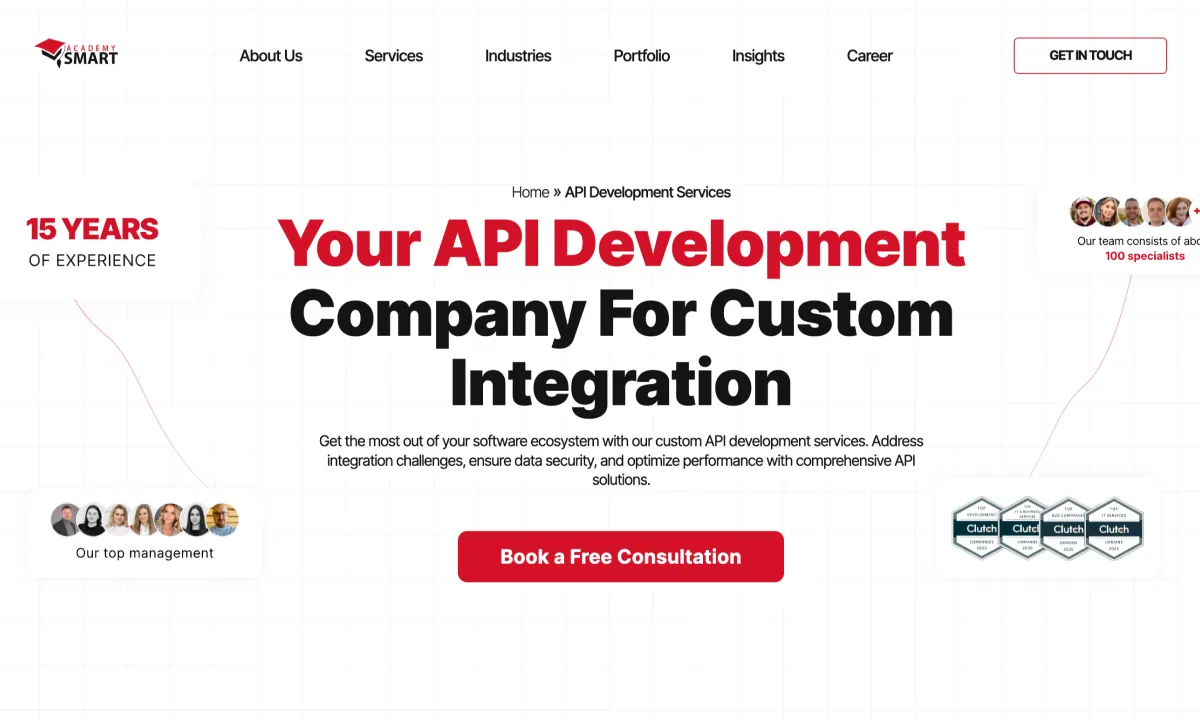
Micro-content as E-Learning trend in 2021
Contents
Introduction
The COVID-19 pandemic did what competition and the productivity race could not—it tipped the scales towards blended learning and corporate training instead of instructor-led education. It created additional demand for E-learning content creation tools and helped various types of E-learning content become more popular. However, drastic measures taken out of necessity can have lasting implications that have started revolutionizing the E-learning industry already:
- 56% of companies around the globe have updated and expanded their corporate training toolkits
- 62% of companies that had to adjust their business models due to the COVID-19 pandemic are actively investing in their staff training in 2021
- 16% more companies use virtual learning now (meaning 16% less use instructor-lead approach)
- One of the biggest challenges in remote education remains the necessity to keep the learners engaged
Microlearning can be the answer to this challenge. While it was on a steady rise as the most popular trend in corporate E-learning for years before the pandemic, current conditions force companies to adopt microlearning at scale. Read on to discover how microlearning can work for your company, how to create E-learning content for microlearning, the top 5 most prominent microlearning trends for 2021, and how to implement microlearning strategies in your organization. Let’s get started!
How Micro-content works in E-learning
As you know, microlearning is the concept of providing and consuming information in a form of bite-sized, easily understandable, 5-7 minute long nuggets. These nuggets might cover a single facet of a larger topic or be a standalone concept and are meant to address a specific learning need, covering a specific topic or skill.
Microlearning is quite well-known in adult education, especially in the corporate training sector. It allows your employees to easily access exactly the knowledge they need to solve a specific task, so they have the information when they need it.
Microlearning types of E-learning content include short videos, checklists, quizzes, flashcards, infographics, labeled diagrams, etc. The learners can access this content as many times as they need to ensure good knowledge retention.
How micro-content benefits E-learning outcomes
Below are 5 examples of how microlearning improves E-learning efficiency.
- According to the Journal of Applied Psychology paper from 2017, microlearning results in 17% more efficient knowledge transfer, as compared to instructor-led training
- 95% of E-learning professionals prefer delivering microlearning, rather than day-long seminars—because their audiences prefer this too
- Based on the SoftwareAdvice findings, corporate employees forget 50% of what they learned within a week if they cannot revisit and refresh their knowledge easily
- Most people have quite limited working memory capacity and an attention span no longer than 7 minutes, so educational videos under this length serve as an ideal knowledge medium
- Modularity improves the ease of microlearning content creation and management
- Modern learners have to operate in a multitasking mode with little time (as little as 1% of the workweek) that can be devoted to education and professional growth

Thus, applying the microlearning approach to delivering corporate training and distance education helps improve learning outcomes, learner engagement and knowledge retention.
Let’s now take a look at the emerging microlearning trends for 2021.
Top Five Microlearning Trends of 2021
There are five E-learning trends that dominate the microlearning arena in 2021:
- Combining microlearning with mLearning
- Adaptive learning through AI-powered analytics
- Game-based microlearning
- Microlearning through real-life scenarios and simulations
- Microlearning with AR and VR features
Below we briefly describe each of these trends to bring you up to speed.
Mobile learning facilitates microlearning
Almost every adult and most kids in developed countries have smartphones and tablets nowadays. This makes mobile learning the ideal choice for delivering just-in-time training. Top E-learning content providers structure their educational materials in small chunks, each of which deals with a single learning goal and can be consumed wherever and whenever a learner needs the knowledge. Thus, mLearning combined with microlearning are on steady rise in 2021.
AI-backed analytics helps provide adaptive learning
LMS analytics features help track and measure every user’s achievements, course progress, exam pass attempts, course content revisits, or the difficulties your learners experience. However, the real value lies with the ability to combine this mountain of raw data with specifically trained AI algorithms.
As a result, you can provide adaptive learning, where a unique path through the course content is carved for every user. Thus, newbies can repeat the material until they get it in full, while professionals can finish the course quickly, skipping the parts they already know. Most popular E-learning content software (like Moodle-based purpose-built LMSs) provide this functionality already. A combination of adaptive learning and AI-backed analytics is a game changer for corporate education.
Gamification and edutainment
Microlearning is not about 1000-word-long text documents. It is about brief videos, infographics, images, podcasts and various interactive elements. It should also include leaderboards, tags and nicknames, badges and a scoring system. The users can accrue additional points for daily time spent in the LMS, acing the tests on the first try and other achievements. This way, the learners are not bored to death and the training becomes an exciting, memorable adventure, not a tiresome slog to wade through.
Real-life simulations and scenarios
Branching scenarios where the outcomes depend on the learner’s decision can be a great way to provide training for most common real-life situations the learners will encounter. By putting them in the microlearning course, you can provide a great opportunity to practice the skills taught in the course. Closing a sales deal, preparing for a safety drill, learning the corporate workflow peculiarities—these use cases are just the tip of the iceberg. Real-life simulations and branching scenarios are a major part of the microlearning evolution in 2021.
AR/VR solutions in training
The emergency signal flashes red, the learner closes the wrong valve and the oil tank blows up, destroying the platform. Well, better luck next time! Put on your VR goggles and repeat once more. This is how the leading oil and gas companies train their employees nowadays. According to the 2020 statistics from MarketResearch, the global VR market is forecast to grow from USD 13 billion to USD 47 billion by 2025.
Other AR/VR applications in microlearning involve performing physical, chemical and biological experiments within the confines of a mobile device. This way, there is no need to buy costly equipment and consumables, as well as no need for physical presence of the learners in the lab, meaning their safety if the experiment goes wrong. Applying AR/VR solutions in microlearning is a great way to cut costs while delivering precise training outcomes.
We have covered the 5 main microlearning trends for 2021, now let’s take a look at how you can implement them to form microlearning strategies for the years to come.

Microlearning strategies for 2021 and beyond
Modern learners work from the comfort (with periodic kids and pet interference) of their homes, but they will have to go back to their offices once lockdowns are lifted. They had to change their working and learning habits to adapt to remote work, but they must not change them back.
Microlearning enables the learners to consume knowledge whenever they need it, wherever they need it, in easily-graspable, concise bite-sized chunks, from any device. The only question remains—what type of content should you include to fit your business goals best?
1. Video-Based Microlearning
Microlearning based on videos helps the educators cover various aspects of literally every topic. By making brief and impactful videos appended with thought-provoking questions, you can ensure the learners will memorize the concept and be able to apply it in their daily responsibilities.
If your videos are to the point, cover a single aspect of a topic per video, and use the visuals similar to the smartphone content your learners are familiar with, you are sure to produce memorable and engaging microlearning content delivering lasting and positive training outcomes.
2. Scenario-Based Microlearning
If the goal of your corporate training program is to train soft skills—time management, leadership, conflict mitigation, etc—scenario-based microlearning is the way to go. By creating real-life scenarios with multiple answer questions, you deliver training close to the experiences the employees will face in work. This also includes learning new strategies and procedures introduced to the company personnel. This type of microlearning strategy helps develop strong problem-solving skills and critical thinking.
3. Gamification And Microlearning
If you have to ensure learner engagement, especially with remote education—gamification is the way to go. By providing various entertaining elements, such as points for completing tasks, progress bars and unlockable achievements, badges and daily rewards—educators can ensure the learners make the most out of the content they are given. By making this content a microlearning one, you can ensure it does not require excessive effort to consume , keeping the learning course an interesting adventure, not a tedious chore.
4. Text-Based Graphics And Animations
When the learner has to read a block of text, and then another, and then another—their zeal drops rapidly. Replace text bricks with gifs, animations, images and other media-rich content to help transform the way the learners consume the course—and the way they perceive the training in general.
Of course, none of these strategies work alone, so you have to mix them and adjust the course content based on the results in order to find the approach that works best for your organization.
How to make microlearning content work
Here are several key points to pay attention to:
- 1 nugget—1 idea. Make it under 7-minutes-long and ensure the content delivery style makes it easy to comprehend the topic
- Embed various tests and quizzes in course milestones to help improve knowledge retention
- Make all the content elements responsive to ensure they are easily digestible from mobile devices
- Develop Offline mode to allow the learners to access content even when offline
- Leverage gamification to keep your users engaged and entertained. Any good user-friendly LMS provides this feature by default
- Pay attention to course completion statistics and adjust the content accordingly
- Microlearning is all about concise knowledge delivered just-in-time. Don’t concentrate on theory too much. Instead, provide the solutions and practical exercises to help learners retain the knowledge better
One of the last (yet most important) questions left to answer is what LMS is good for delivering and managing microlearning content? Based on Academy Smart experience, most multi-tenant LMS platforms provide the full range of features required to import, curate and manage various types of E-learning content.
Summary
To briefly recap the article: microlearning is not new, but it is rapidly growing in popularity due to the COVID-19 induced lockdowns. While we start seeing vaccination across the globe, 2021 will still be mostly spent working and learning remotely— so microlearning is here to stay.
The key aspects of successful microlearning implementation as the corporate education and E-learning trend in 2021 revolve around providing your audience concise, bite-sized and easily digestible nuggets of knowledge just-in-time when they need them, from the convenience of their mobile devices.
If none of the E-learning content software fits your taste — Academy Smart is ready to provide a purpose-built LMS that will help you successfully implement microlearning in your company. More details on how to select the best tools and approaches for your E-learning strategy can be found on our whitepapers page. If you need more in-depth advice on the main benefits of an LMS you should look for—take a look at E-learning explainer videos on our YouTube channel.
Should you have any other questions or concerns related to microlearning implementation for your organization—get in touch, Academy Smart is always ready to assist!
Book a free consultation

Reach out to start talking today!











